1lumen selects and reviews products personally. We may earn affiliate commissions through our links, which help support our testing.
Fire-Foxes FF5GT review
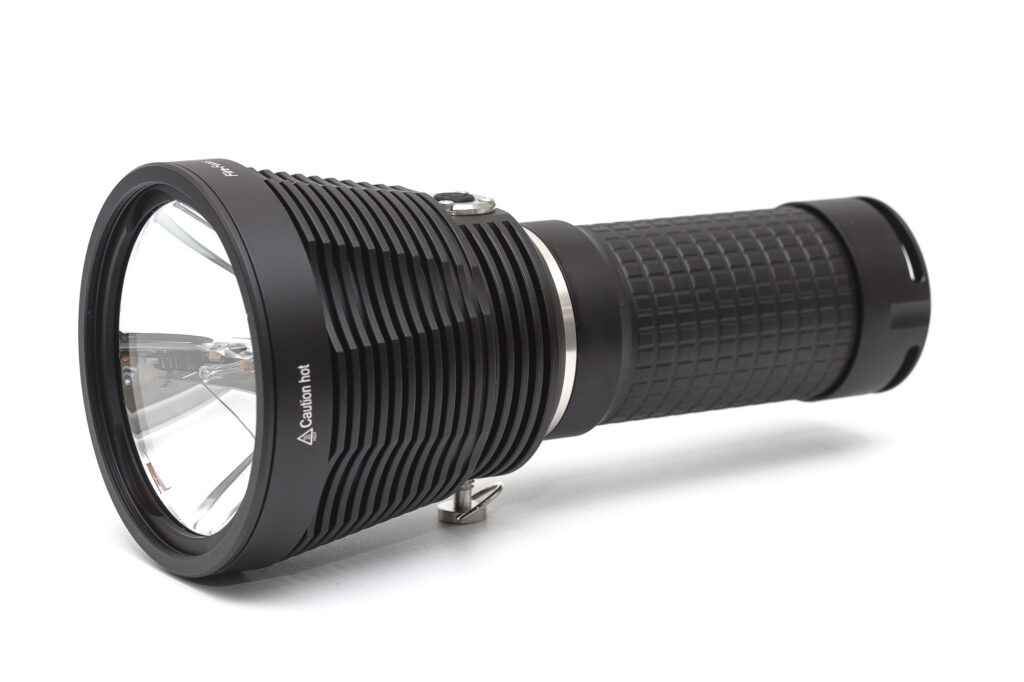
Fire-Foxes FF5GT specifications
| Brand/model | Fire-Foxes FF5GT |
|---|---|
| HID type | 150W HID (4300K) |
| Max. Lumens | 15,000 lm |
| Max. Beam intensity / distance | 1,200,000 cd (2400 meters) |
| Battery config. | 4*18650 |
| Onboard charging | N/A |
| Modes | 2 |
| Blinkies | – |
| Reflector | Smooth |
| Waterproof | IPX7 , IP67 |
| Review date | August 2022 |
Introduction:
I’m the first to admit that I don’t know too much about HID lights. Because this is my first! I’ve contemplated in the last decade whether I should get one or not. But I never pulled the trigger. So here we are, at my first (and in the community one of the most exciting as of today) HID flashlights. FireFoxes has a long history at Budgetlightforum, where I got to know them from, and was first introduced to them around 2012 I think. Fast forward 10 years and we have had about 2-3 different variations between the then FF3, and this FF5GT. And it’s only been 2 years ago since the FF5 was introduced as a 100Watt HID, and now the FF5GT is sold as being a 150Watt HID…
So, basically, this is kind of old-school technology, (HID stands for High-Intensity Discharge), and has been around for at least a century, according to my Google searches.
For some people this brings back memories from the past, but for me, this is actually my first time experiencing it first-hand. And I must say, it’s a very interesting experience. But if you know what LED flashlights can do these days, I understand that not many manufacturers will build new HID lights.
BTW. My version is the 4300K.
Package quality.
I received a pretty standard brown carton box with a neoprene bag inside, containing the FireFoxes FF5GT, and a few more things. It didn’t come with batteries, but you can order them together with the light.
- The flashlight: Fire Foxes FF5GT
- Neoprene pouch
- Lens cap (to protect the front glass)
- Manual (Chinese only)
- Carry strap with accessories
- Spare o-rings
Besides these basic accessories, there are some optional accessories available as well. I will add them to a list:
- Spare battery carrier
- Frosted filter (to get a wider beam)
- Spare HID bulb
- Lens
- Lens cap
- Protective leather pouch
- Long battery tube (with 8 batteries built-in, and charge port)

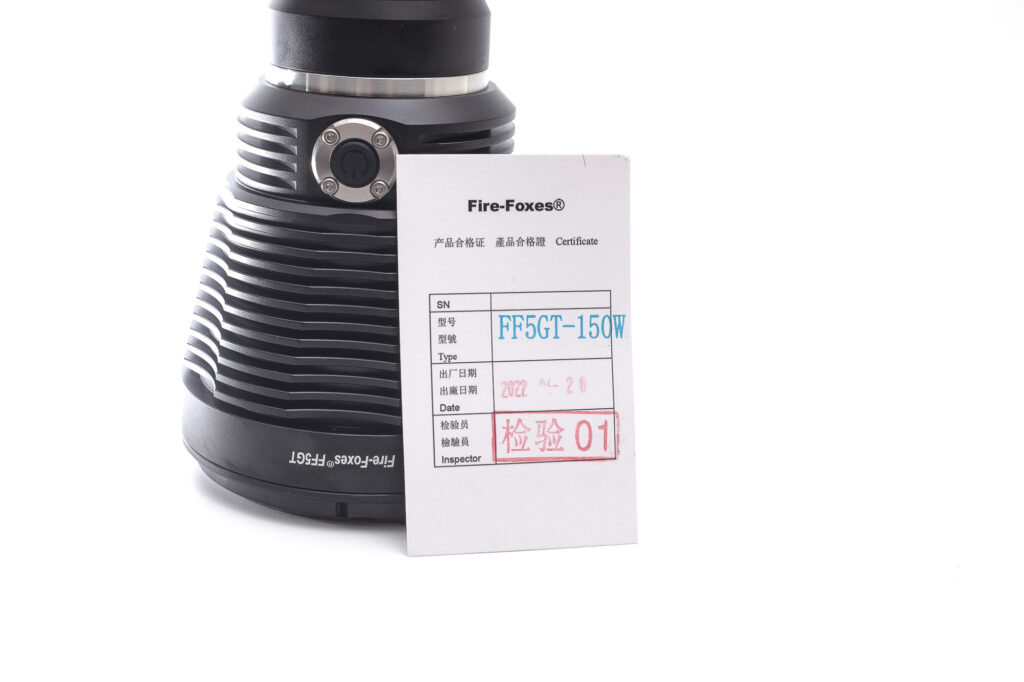
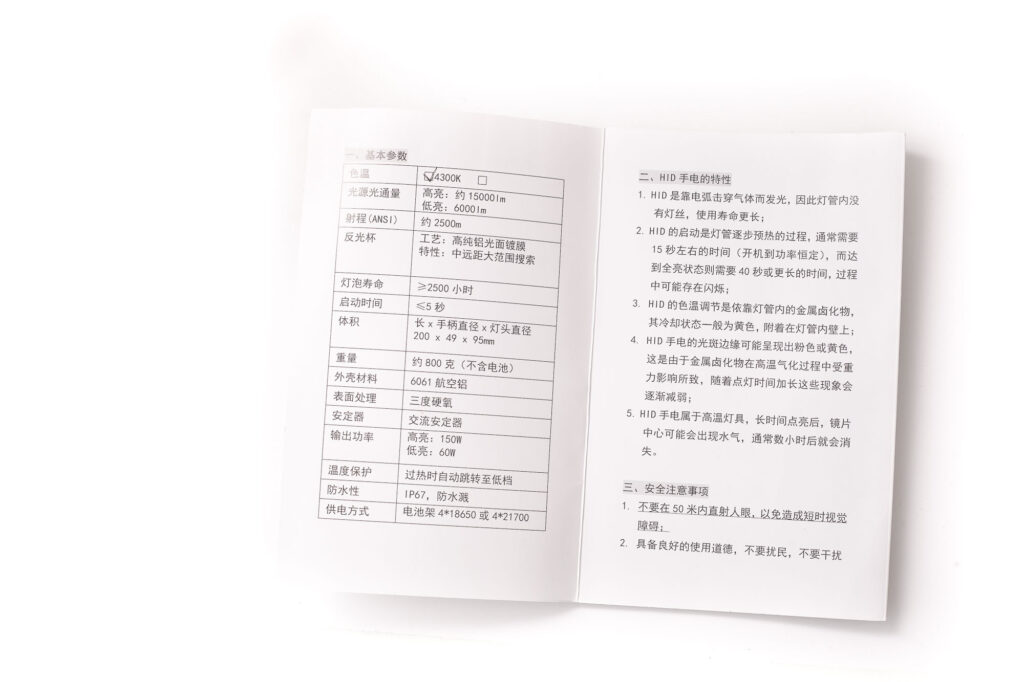
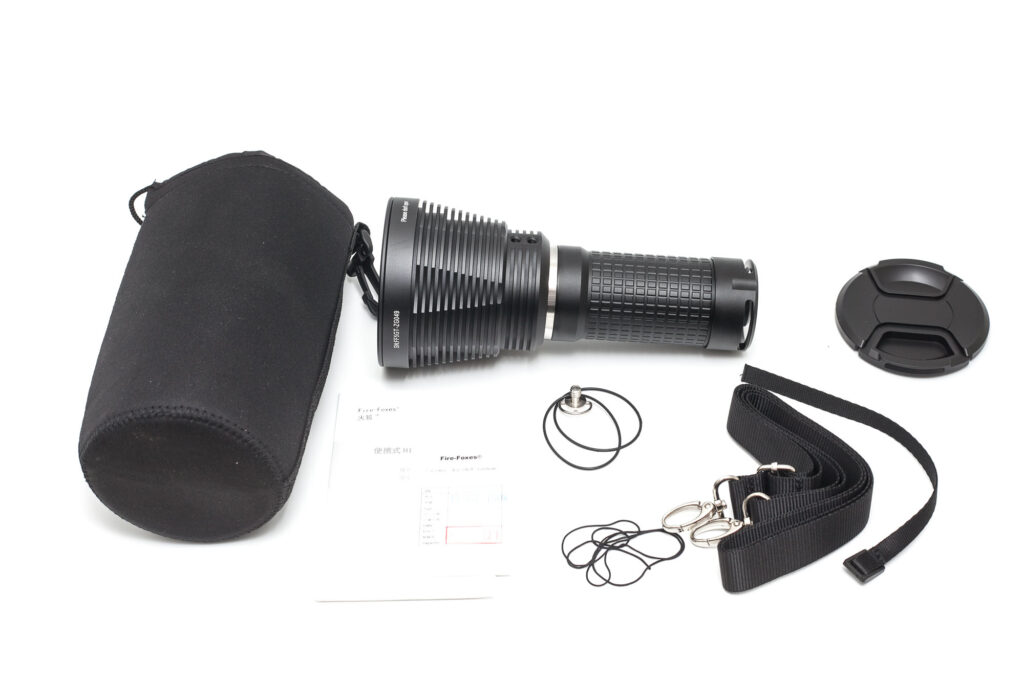
Flashlight in use
If you look at the images, you get an idea of the size of this monster. Not that it’s extremely large, but it’s definitely quite a bit bigger than most available flashlights. And it also has some weight to it, albeit not extremely heavy either.
Although the head is the spot where all the weight is, the battery carrier loaded with 4*18650 batteries makes it relatively balanced. But that doesn’t take away the pretty large battery tube, which makes it a little hard to carry for a long period of time. Especially if you have small hands.
To operate the FF5GT, you need to activate the rear switch first. Once you see the backlight in the tailcap, you activated the batteries (without activating this, it won’t work). Then you can use the side switch to switch between high and low. It has only 2 modes.
There’s machining on the battery tube, that makes it feel quite comfortable to carry, without having any sharp edges or anything. And although the batterytube gets saturated with heat, it didn’t get too hot to hold.
If you’re worried about getting tired of carrying it by hand, you can use the included carry strap or the neoprene pouch. Just note, that my pouch broke the first time I used it. Not great quality.
The beam of the FF5GT is pretty ‘throwy’, so it’s best for long-range scenarios, like searching, (search and rescue), or as an around-the-yard light when you live on a farm. Because of the throw beam, it’s not very useful for close-range tasks, unless you get the optional diffuser lens.
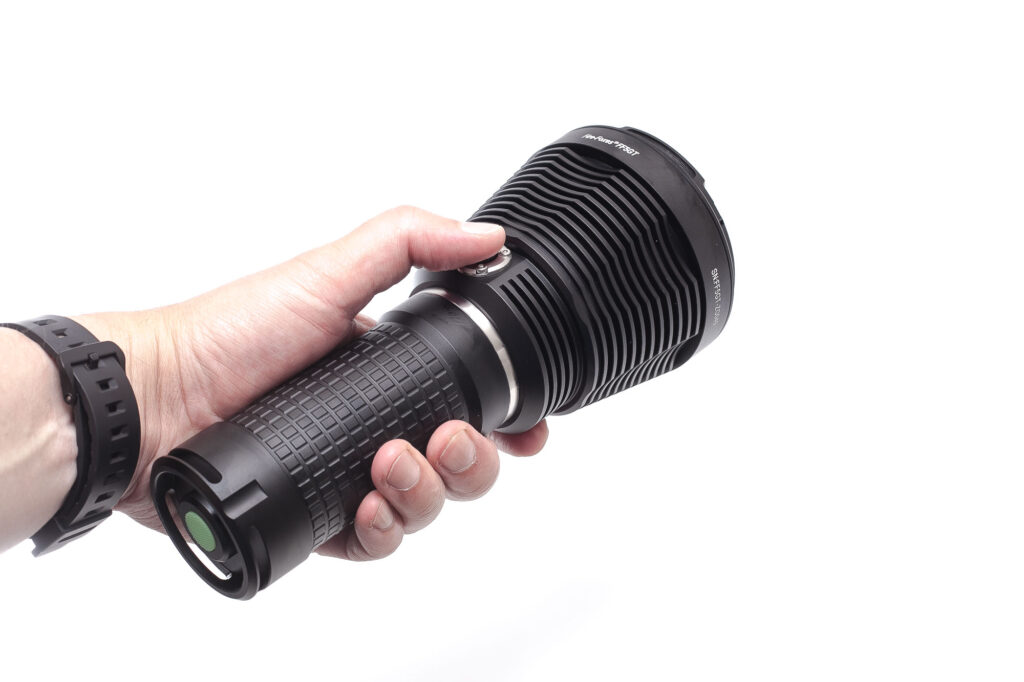
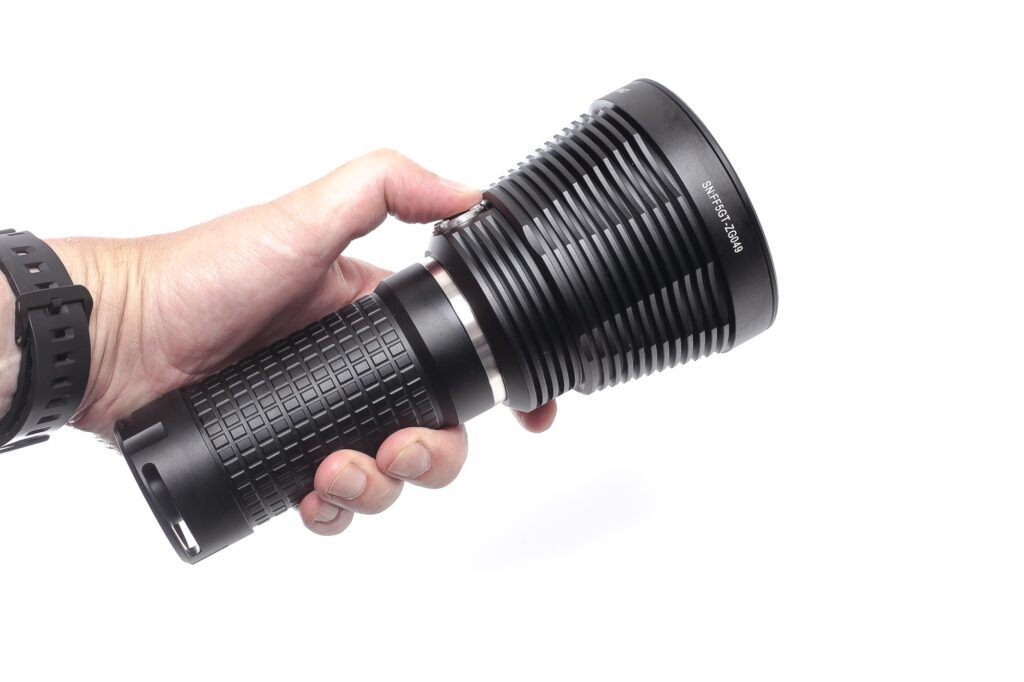
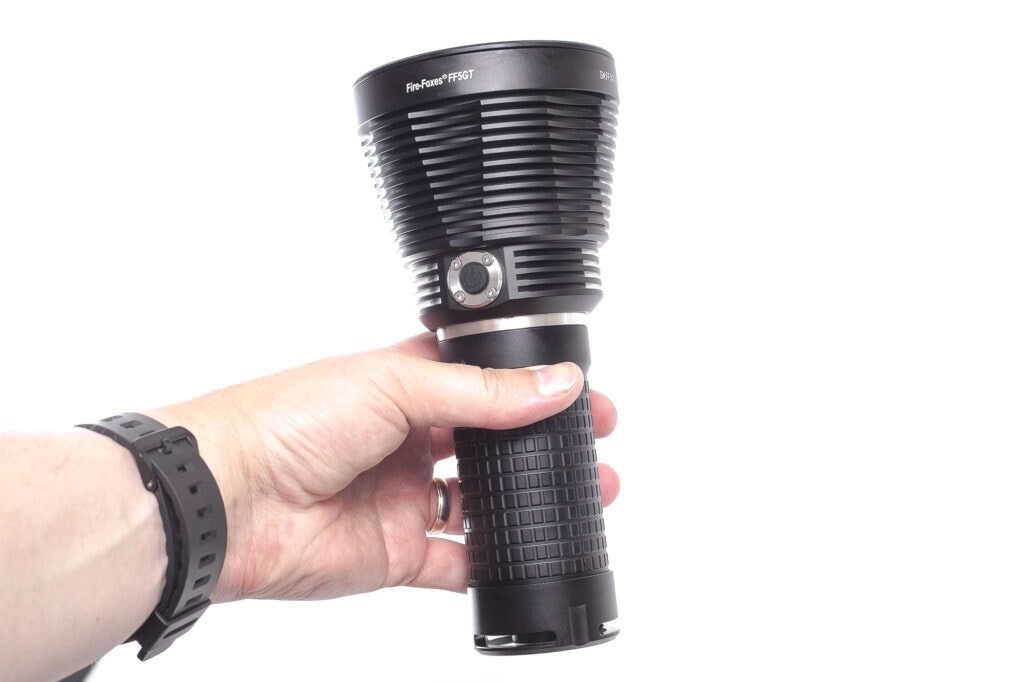
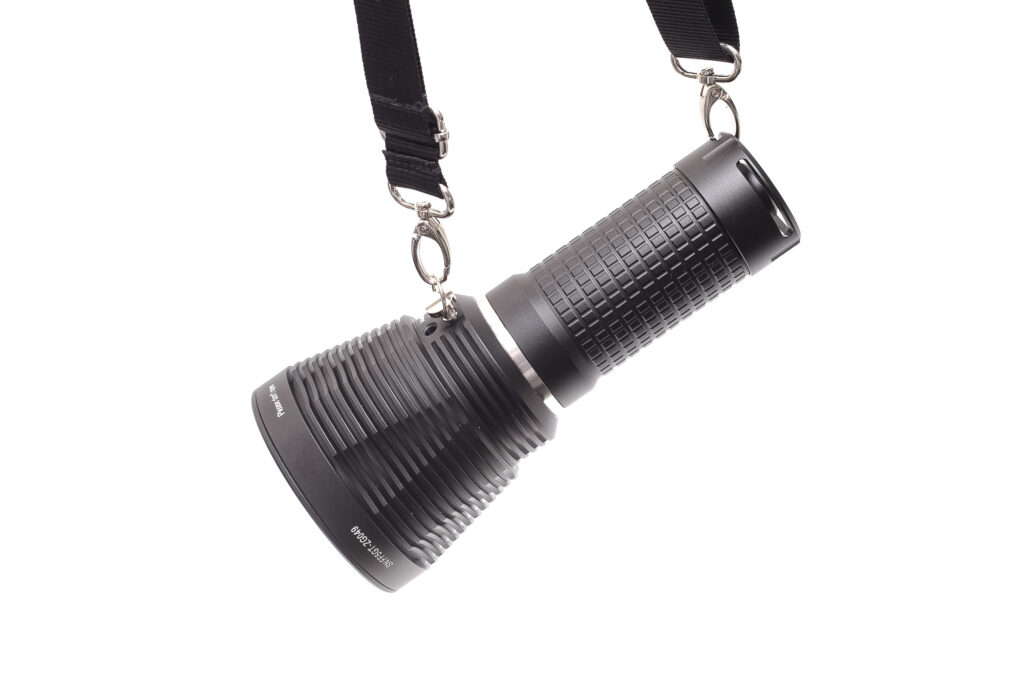
Build Quality, and Warranty
At first I unscrewed the battery tube to remove the battery carrier. But after doing this a couple of times, I accidentally unscrewed the silver contact plate, with the 2 wires going to the ballast.
Then I decided to leave that alone, and just unscrew the tailcap. Which I didn’t know could be unscrewed at first.
The battery carrier looks a little old school, and I would have liked to have it 4*21700 instead of 4*18650. I would also have preferred it to be made of metal or just a bit stronger. Not that it is likely to break easily, but it doesn’t look very strong. The threads near the tail cap are anodized. The threads pm the contact plate are sharp. I tried to remove the contact plate to see whether something inside was broken, and it cut my hand.
Unfortunately, without any force, I accidentally removed the plastic around the switch. This happened while removing the batteries from the carrier.
When it comes to the accessories, the pouch is pretty low quality. It tore the first time I tried to close it. So much for that.
Also, the screw (that connects to the carry strap) sticks out a lot. It doesn’t sit flush, and I don’t know the reason for this. But I would have preferred to let it sit tight and flush… not with a gap of 3-4mm like it is now. Or, perhaps that’s done with a reason. Who knows.
The overall quality? Hmmm, I won’t rate it very high in that regard.
Warranty?
Mine broke without me having a clue how it happened. Maybe because I cleaned the contacts with rubbing alcohol, on both the battery carrier as well as on the contact board (which is connected to the rest of the light with thick wires. Update: Neal will look into the actual warranty, and I will send it back to him.
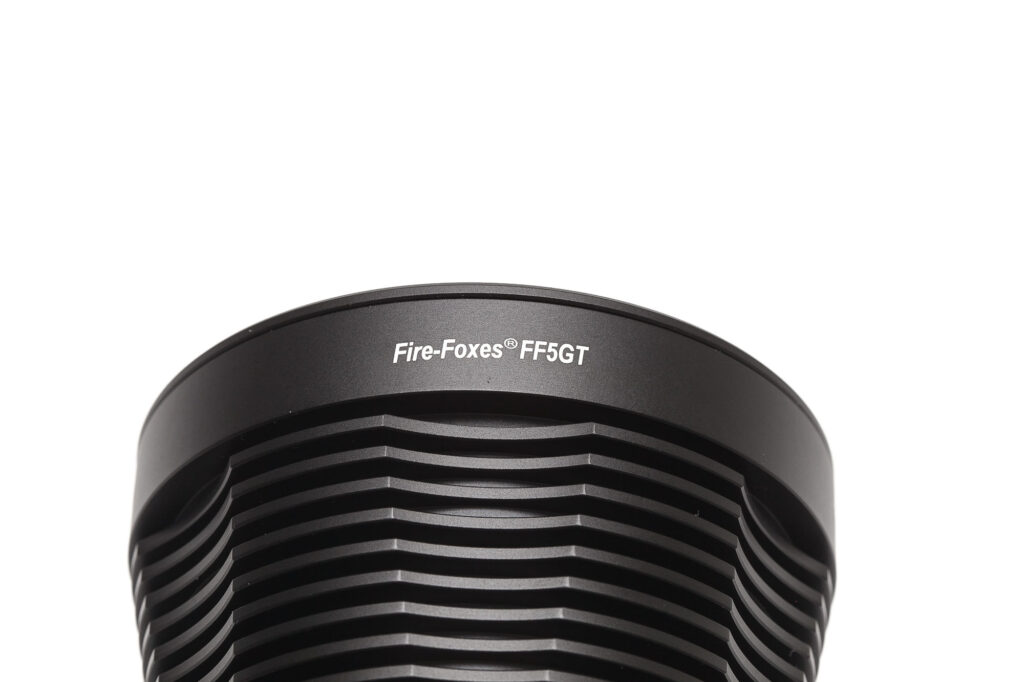
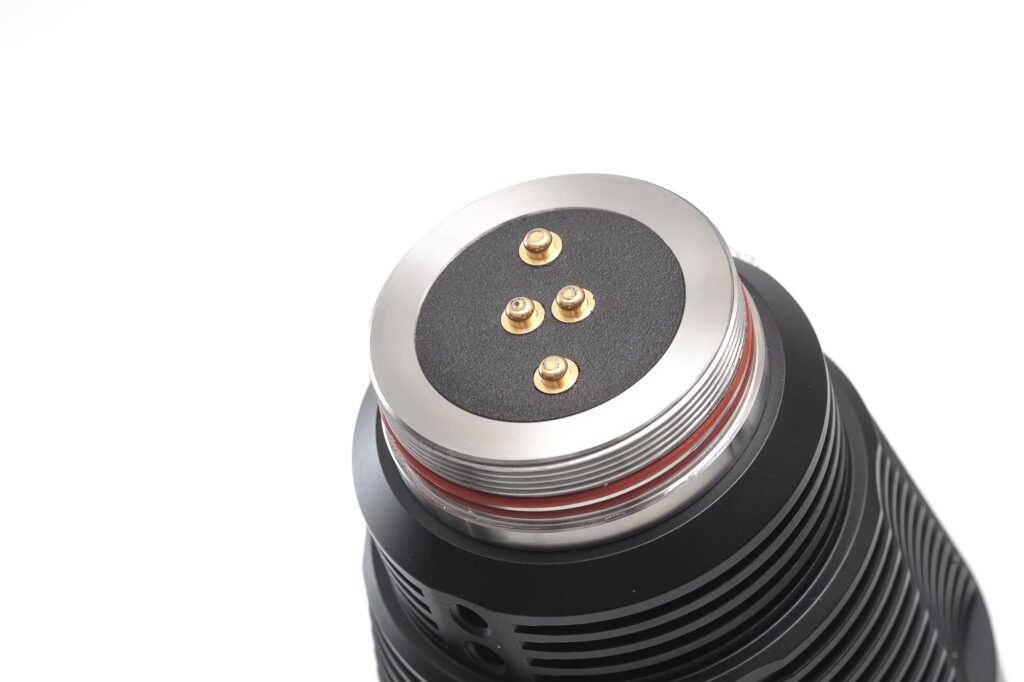
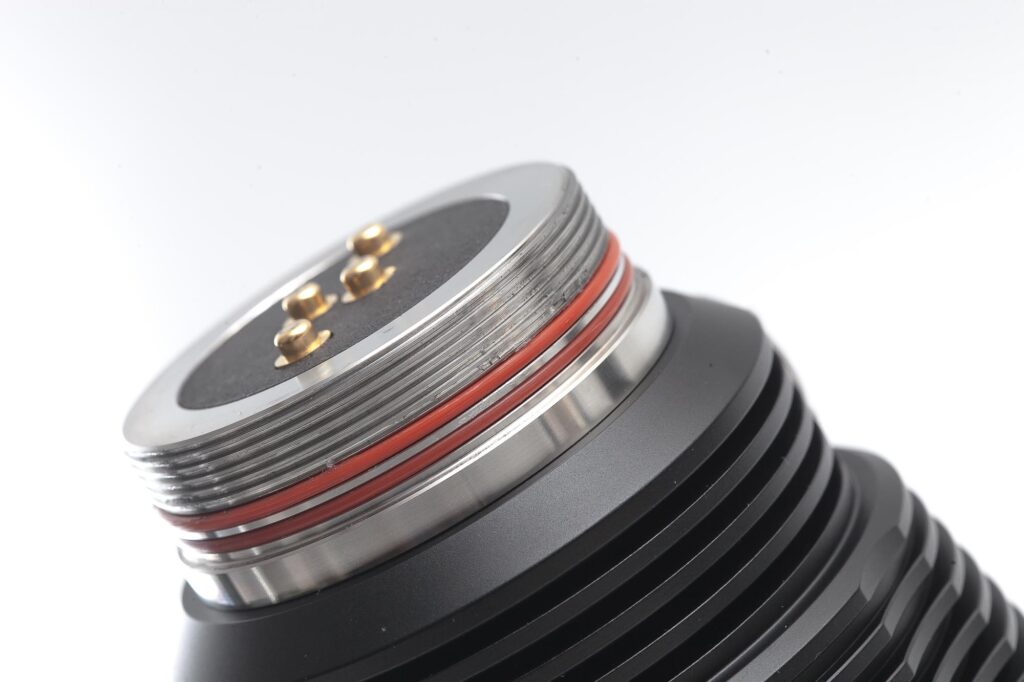
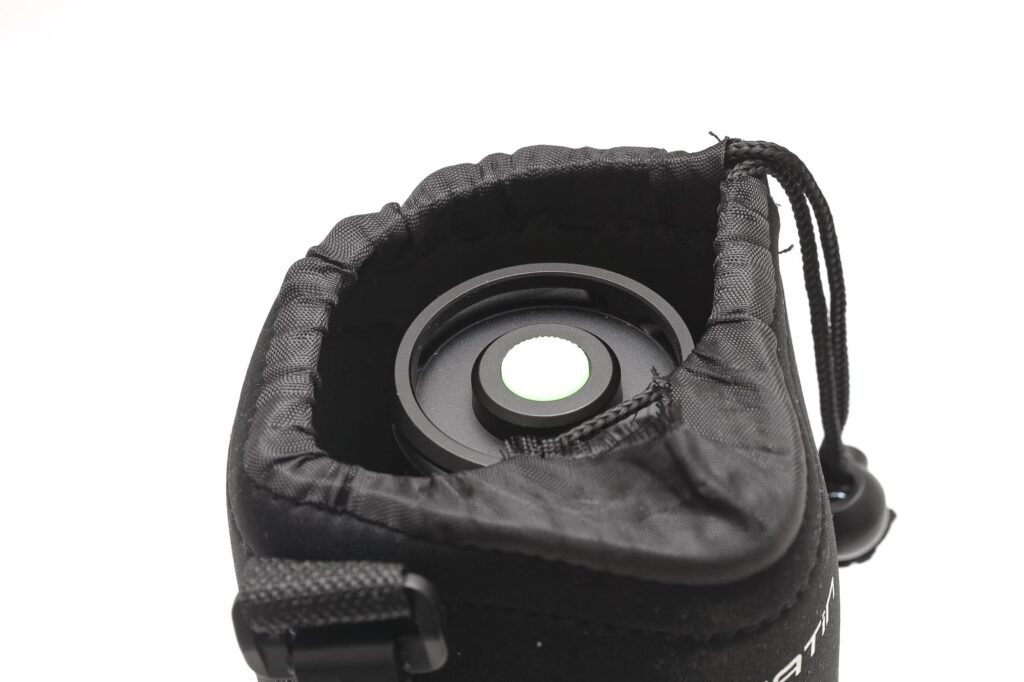
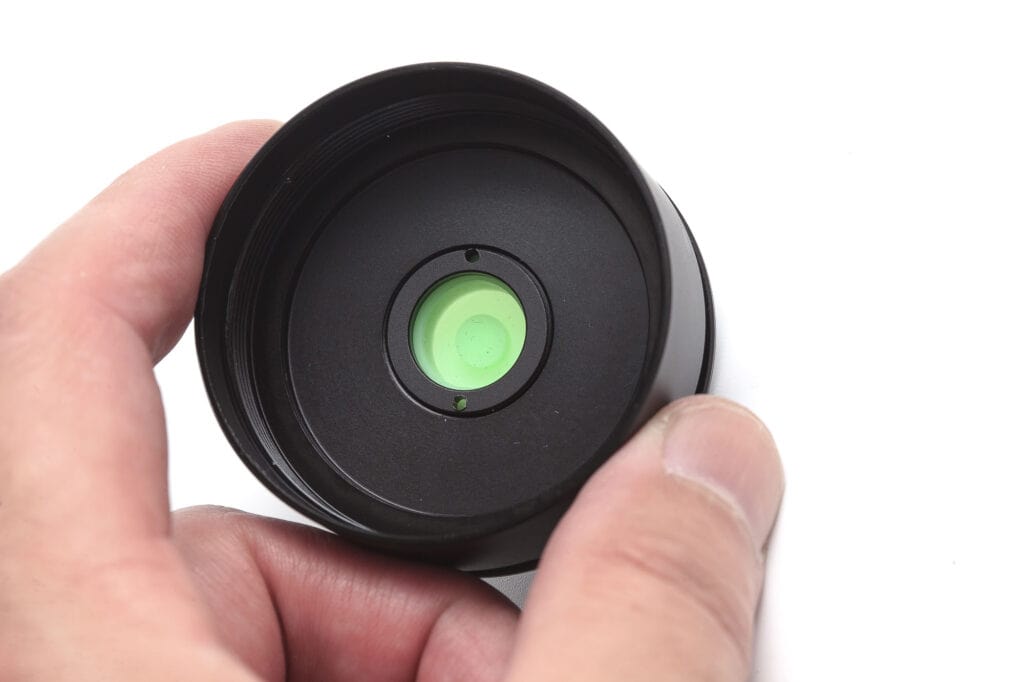
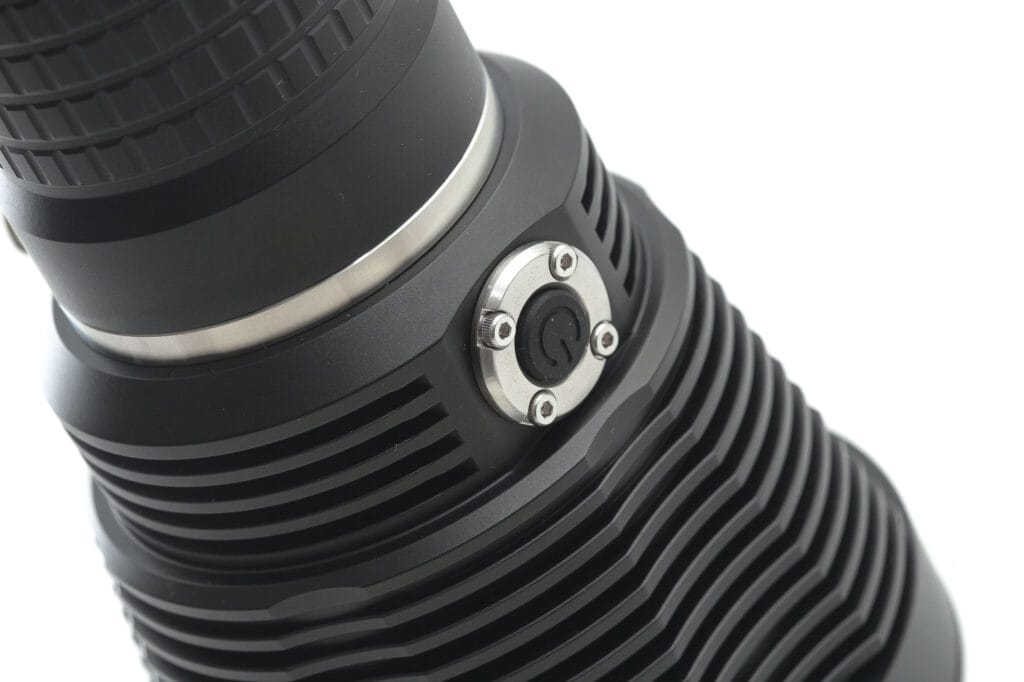
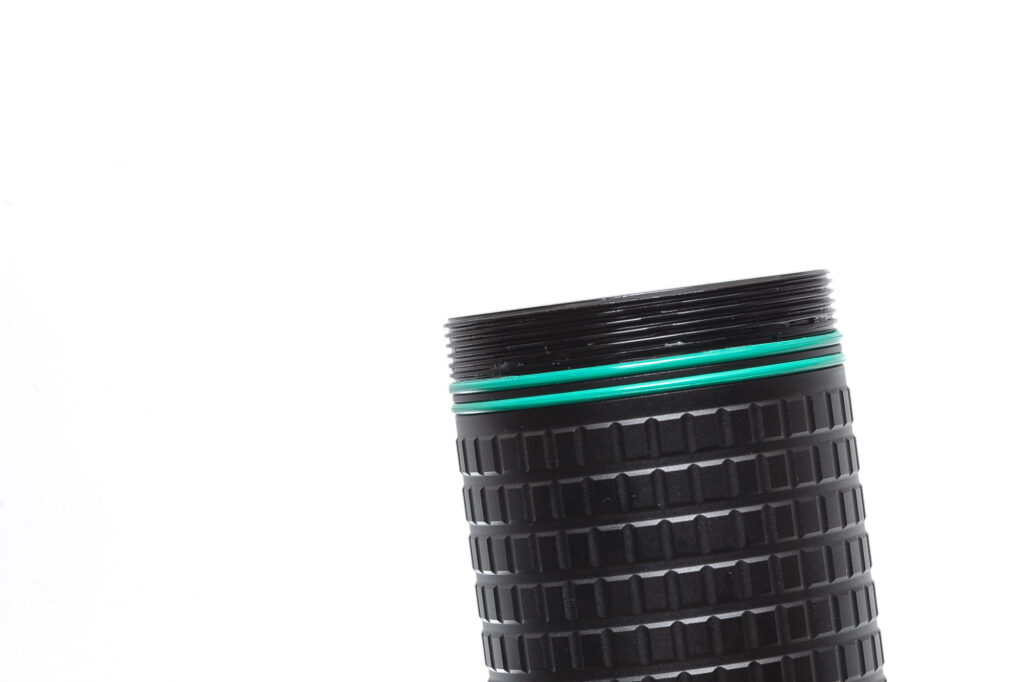
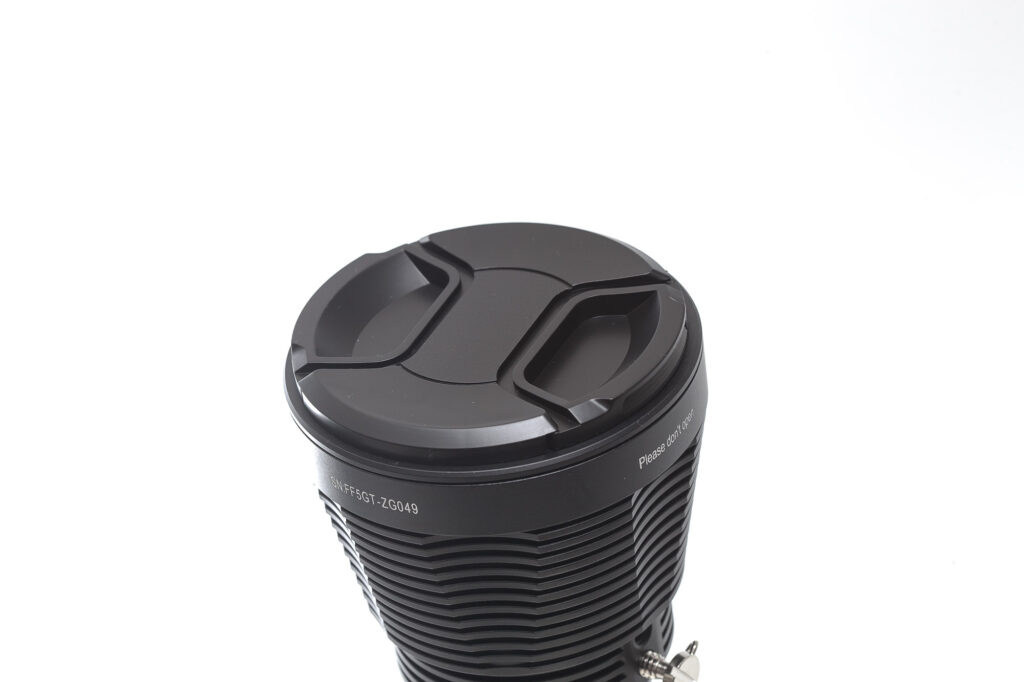
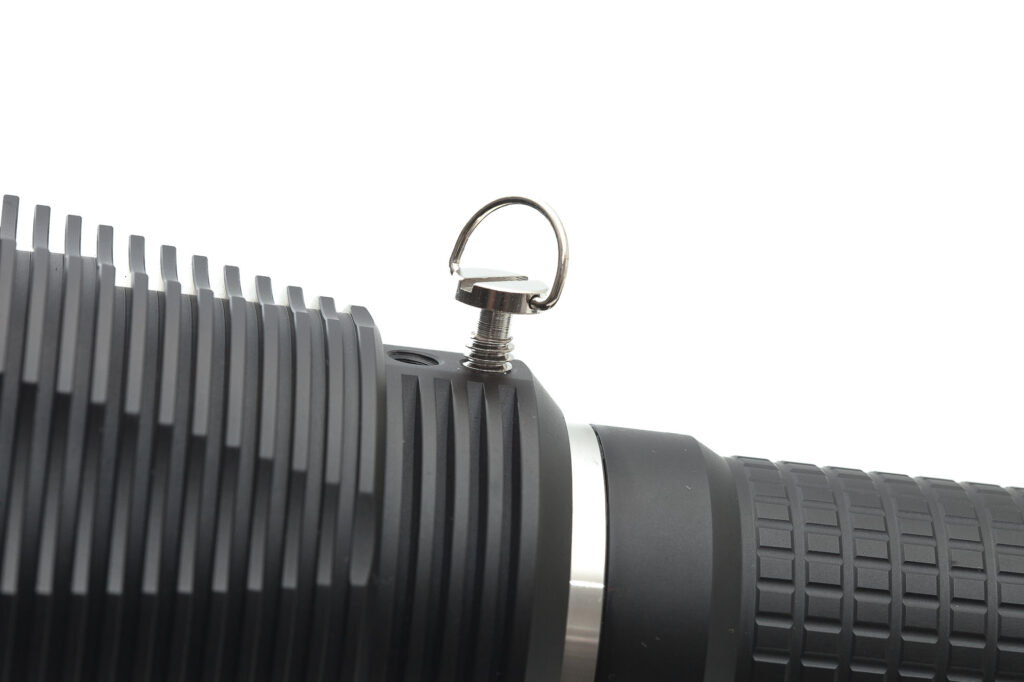
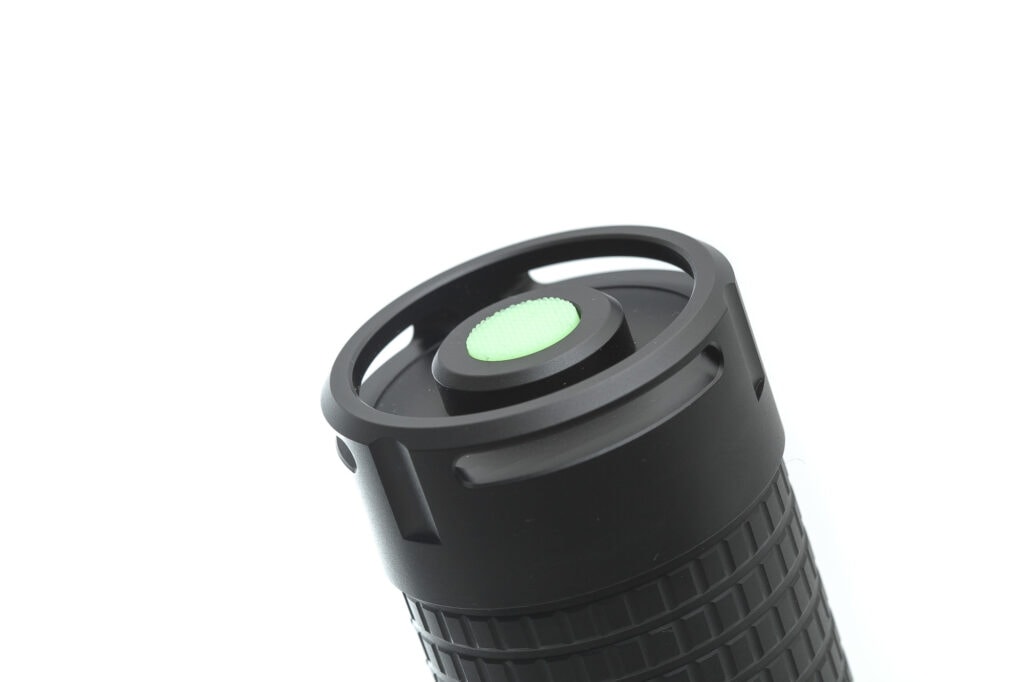
HID, Lens, Bezel, Beam, and Reflector
The FF5GT can be bought with 2 different CCTs. A neutral white at 4300K (the one I am reviewing) and a cool white with 6000K.
I got the 4300K, which is a bit hard to measure, because of the tint shift at turn on, and the artifacts in the beam. The beam is very difficult to describe, especially when you turn it on, it turns into different tints and temperatures. And even when the light is in its sustained output, the beam looks fascinating. Much different from your average LED flashlight.
I’ll refer to the beamshots below to get some idea of what it looks like.
It has a very smooth reflector that should maximize the beam’s reach. And according to specs should reach about 2400 meters. I’ll dive deeper into this, in the Performance section below.
The bezel is aluminum, and the glass lens can be protected by the included camera lens cap. I’m pretty sure it’s just a standard camera lens cap, although the diameter is pretty large at 86mm. That’s larger than most camera lens diameters go.
Unfortunately, I couldn’t measure the light temperature etc.. because it broke before I could test this.
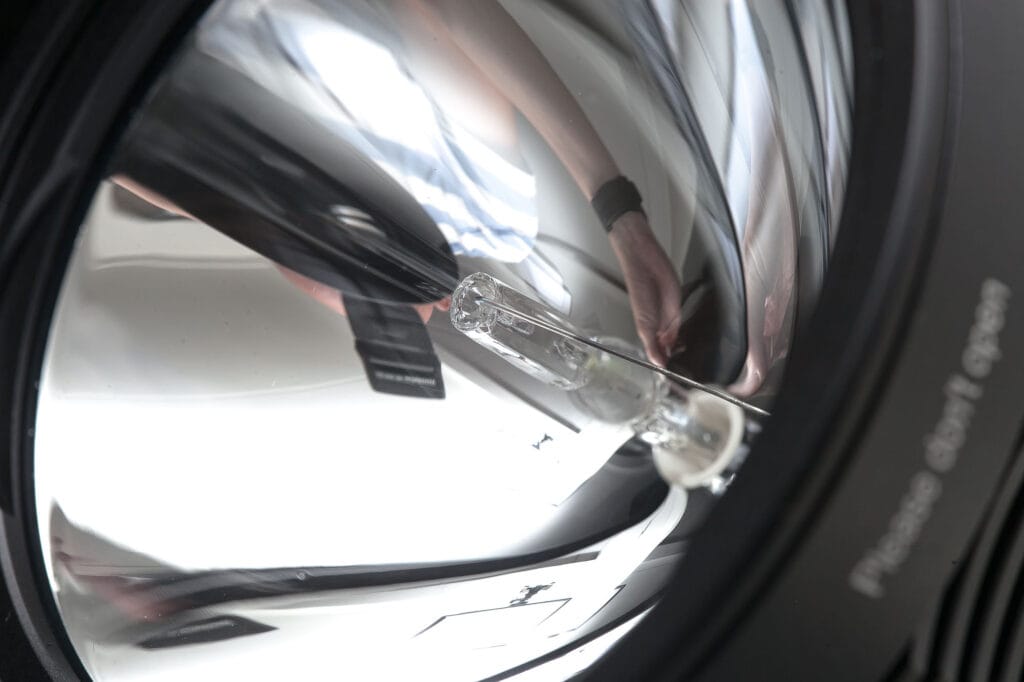
Dimensions and size comparison
Dimensions:
| Millimeters | Inches | |
|---|---|---|
| Length | 206 mm | 8.11″ |
| Head diameter | 95 mm | 3.74″ |
| Reflector diameter inside | 77.2 mm | 3.039″ |
| Body diameter | 49.7 mm | 1.958″ |
Weight:
| Weight in grams | Weight in Oz. | |
|---|---|---|
| Without batteries: | 817.6 grams | 28.84 |
| With batteries | 1009 grams | 35.59 oz. |
High power flashlights comparison
Size compared to other high-power thrower flashlights
Group 1, from left to right: Astrolux MF04S, Acebeam K65, Fire-Foxes FF5GT, Acebeam X45 II
Group 2, from left to right: Astrolux MF04S, Acebeam K75, FireFoxes FF5GT
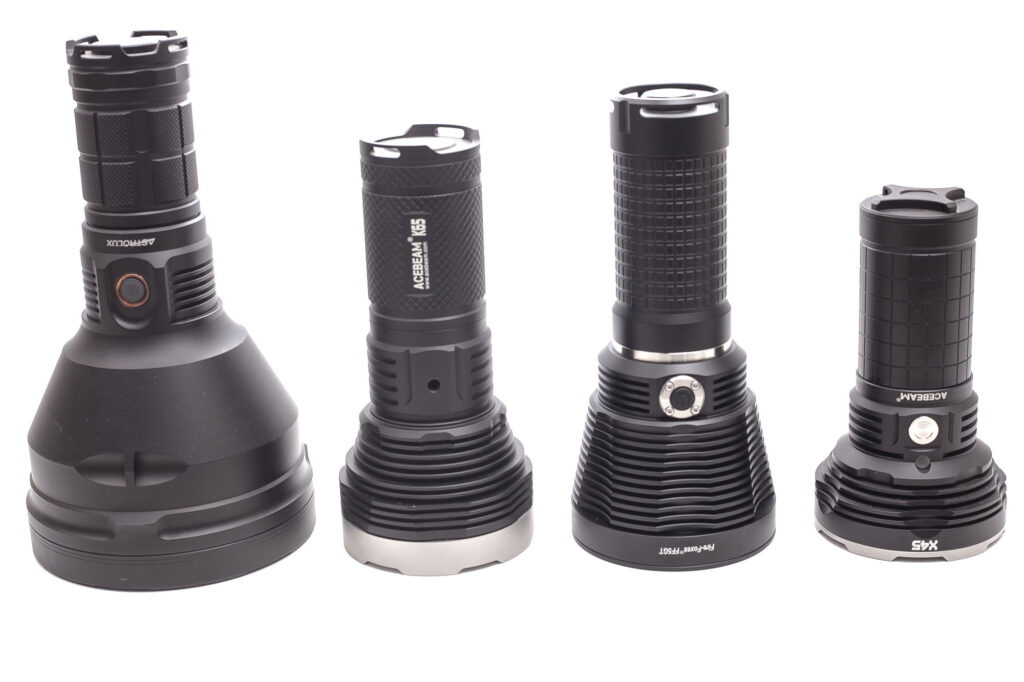
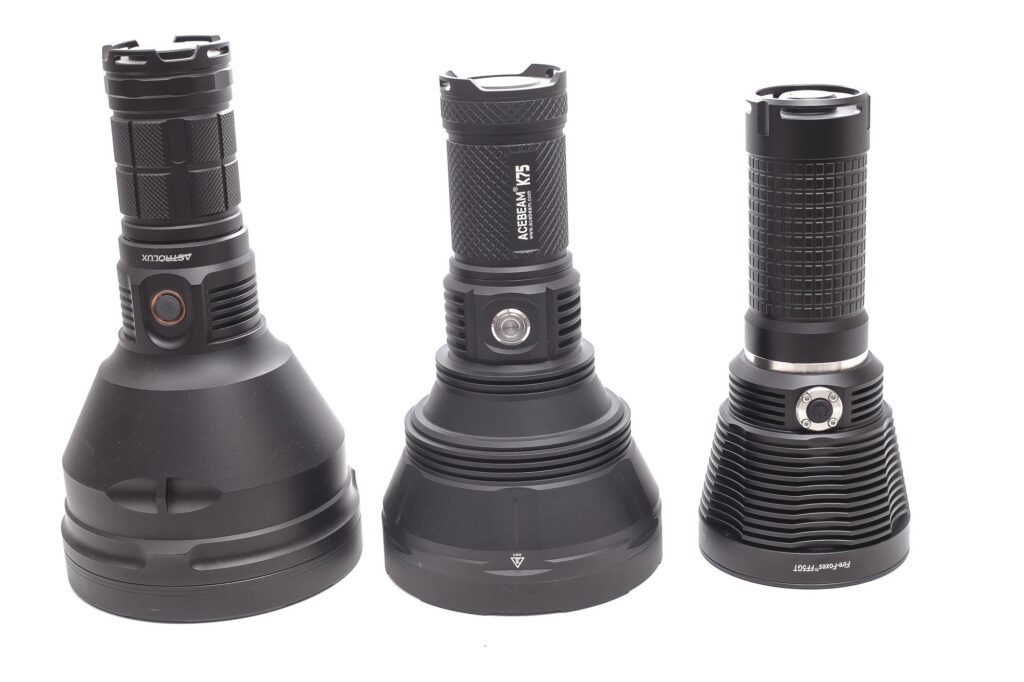
Driver & User Interface:
Why make it difficult? There’s a rear switch (for power) and a side switch (to toggle between high and low). But the funny thing is that the rear switch is actually the switch built onto the battery carrier.. yes, strange.. Anyway… here you go:
Available modes:
- Low, High
From OFF:
- Rear switch: power
- Single-click rear switch: power on
- Single-click side switch: nothing
From ON:
- Single-click rear switch: power off
- Single-click side switch: change modes Low – High
Shortcuts:
- None
Mode memory:
- I think so
Blinky modes menu:
- None
Low battery warning:
- Output drops, and the runtimes are very short anyway
Lock-out mode:
- Just use the tail switch
PWM:
- It doesn’t, but it has some sort of visible flickering, especially after turn on
Firmware / UI Conclusion:
The UI is very simple, and straightforward
Batteries & Charging
It seems to me, that the battery carrier, and the whole system around it, hasn’t been updated. It would have been great (better) to upgrade from a 18650 to a 21700 battery carrier. They would be able to really push the flashlight to the limits. And even better, include a battery tube, and battery carrier for 8 cells.
Button tops don’t fit, not even unprotected button tops! The only batteries that fit, are flat top, unprotected 18650.
The switch is actually built into the carrier, and there’s a plastic cover glued on top. Unfortunately, it got loose by accident, after removing some tightly fit batteries.

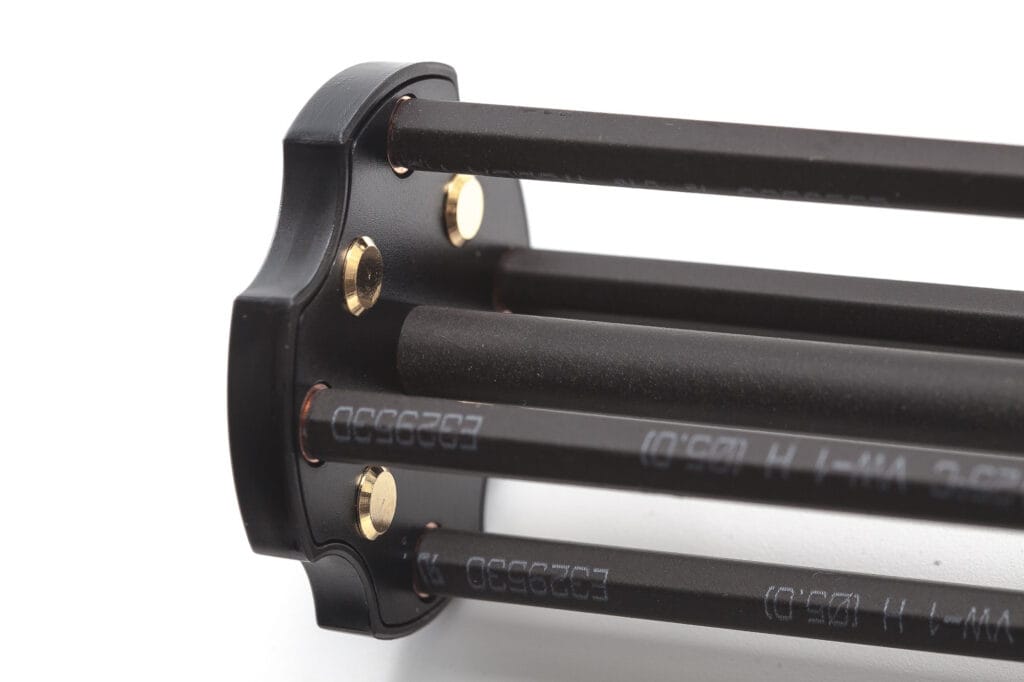
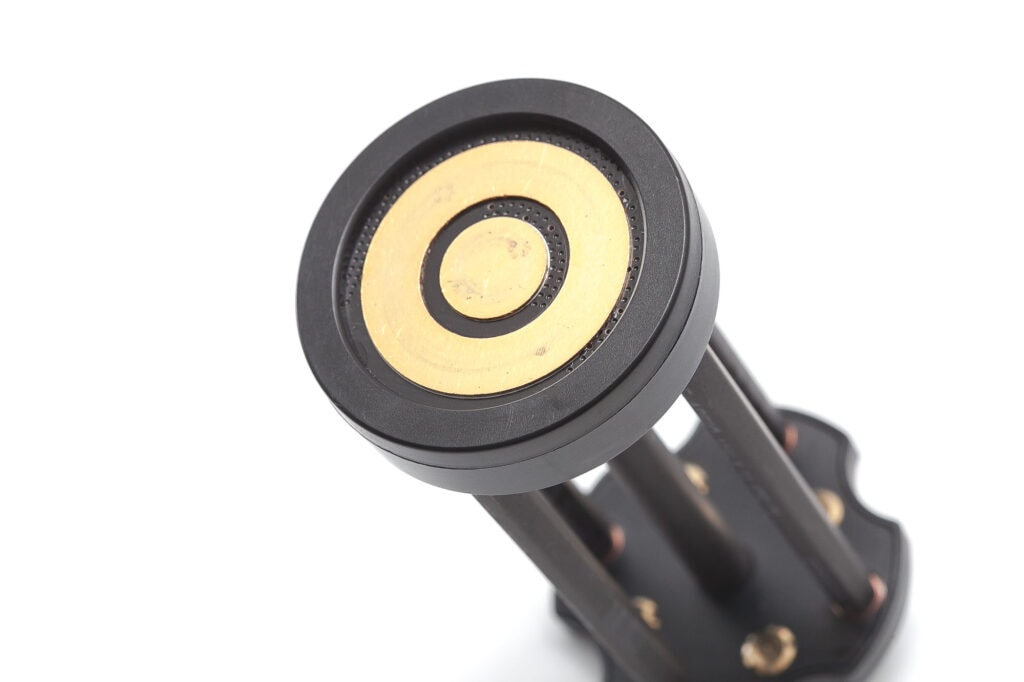
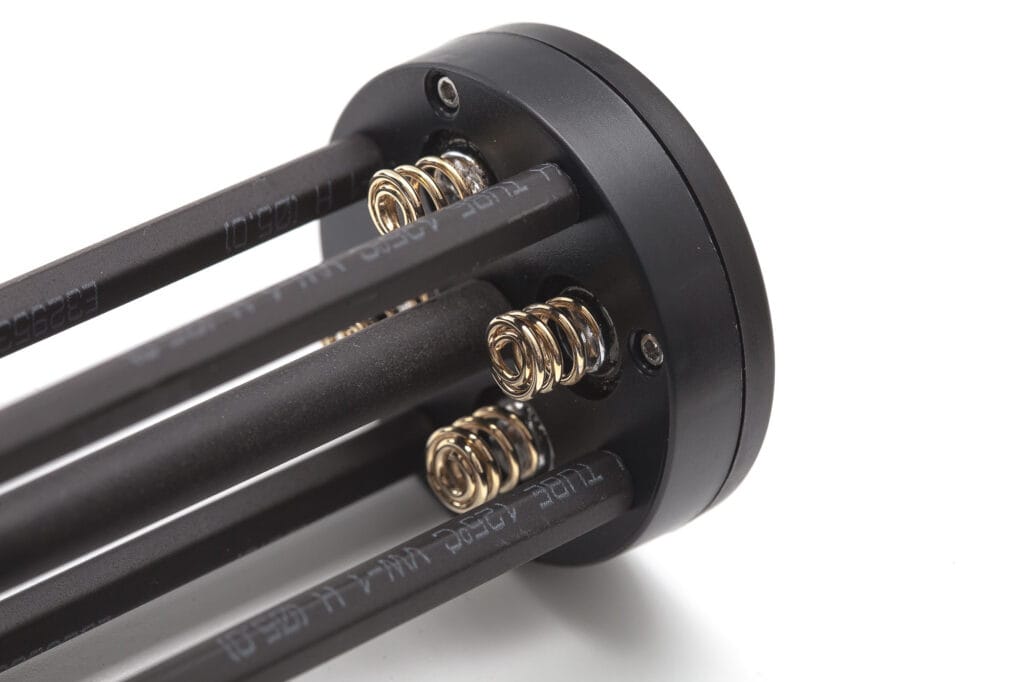
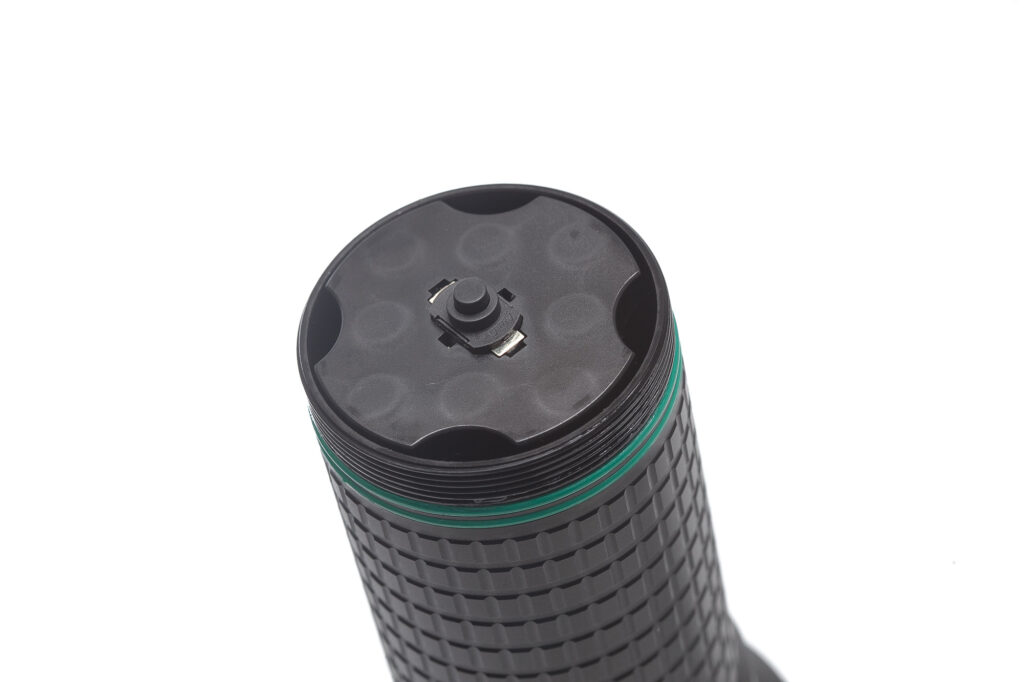
Performance test
Lumen measurements:
All output numbers are relative to my homemade Integrating Sphere. It is set up with an Extech SDL400 Lux Meter for measurements including a Kenko PRO1D ND-16 filter. The base measurement is done with a Convoy S2+ that has been tested at 255 lumens.
All of my readings were taken from fully charged Sony VTC5A. And I also tested with Samsung 30Q which were just very slightly lower… not much though.
These are manually tested, except for the 10 minutes reading. That one is taken from the runtime test.
| Mode (time) | Specs | Lumens |
|---|---|---|
| Low 30 sec | 3601 lm | |
| Low 60 sec | 3821 lm | |
| Low 90 sec | 3829 lm | |
| Low 120 sec | 3845 lm | |
| Low 10 minutes (from runtime) | 4049 lm | |
| High (highest measured) | 15000 lumens | 11,236 lm |
| High 30 sec | 9282 lm | |
| High 60 sec | 8788 | |
| High 10 minutes (from runtime) | 4030 lm |
The highest output point is at about 10 seconds or so, at turn on it’s much lower, because it increases brightness. I used a fan for testing High.
You can see that Low mode increases brightness slowly. And therefore the 30-second measurement is lower than the 1-minute or 10 minutes measurement.
It wasn’t able to come close to the advertised 15,000 lumens.
Fire Foxes FF5GT Battery life and runtime graphs
The runtime test was done with the 50cm integrating sphere, including the Kenko Pro1D ND-16 filter and Extech SDL400 data logging Lux Meter.
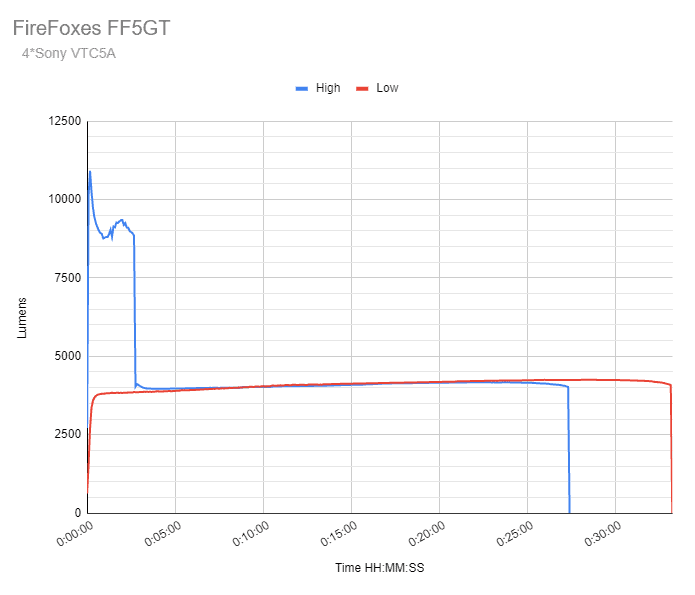
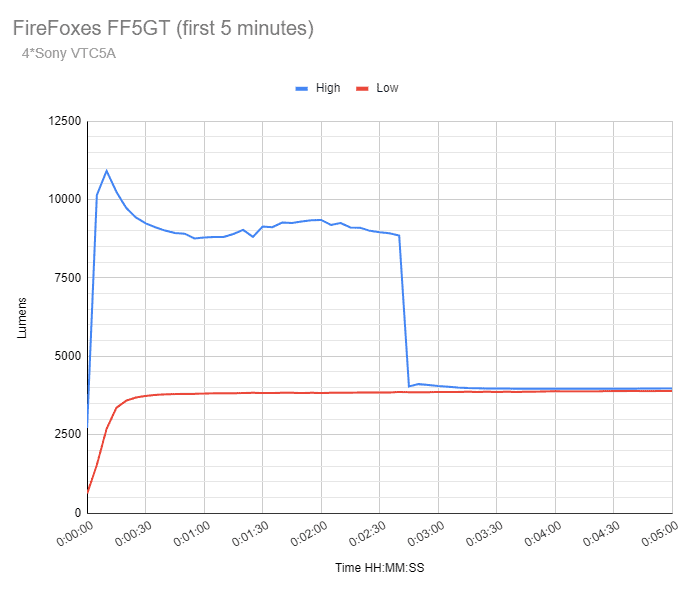
| Mode | Specified | Measured runtime (ANSI FL1) | Time till shut off |
|---|---|---|---|
| Low | – | 33 min | 33 min |
| High | – | 27 min | 27min |
As you can see, the runtimes are very short, compared to their LED counterparts.
ANSI FL1 standards: The runtime is measured until the light drops to 10% of its initial output (30 seconds after turn on). This does not mean that the flashlight is not usable anymore. The last column shows how long the light actually works till it shuts off. If there is a + symbol, it means that the test was stopped at that particular point, but the light was actually still running. This happens on certain occasions, with certain drivers, firmware, or batteries.
FireFoxes FF5GT Peak beam intensity and beam distance measurements
Measurements were taken outdoors at 20 meters and indoors with a Hagner E4-X Lux Meter. Here are the numbers.
| Mode (time) | Specs | Candelas measured | Meters | Yards |
|---|---|---|---|---|
| Low 30sec | 268,000 cd | 1035 | 1132 | |
| Low 60sec | 288,000 cd | 1073 | 1174 | |
| High (done after testing low) | 860,000 cd | 1855 | 2028 | |
| High 5 meters 30sec | 1,400,000 | 897,500 cd | 1895 | 2072 |
It doesn’t even come close to the claimed output. And no, changing from Sony VTC5A to Molicell P28A wouldn’t increase throw by 50%. Proof me wrong… with data!
Extra info: Peak beam distance according to ANSI FL1 standards: The calculated value of distance in meters at which the flashlight produce a light intensity of 0.25 lux. (0.25 lux is about the brightness of a full moon shining on an object).
Beamshots
For the following beamshots I used a Canon EOS 5D Mk2 and a 100mm lens. manual settings: ISO1600, .5sec , F4, 5000K
The tower is about 450 meters / 492 yards away.
The next round is done with a Canon EF 50mm lens. manual settings: ISO1600, 1/4sec , F4, 5000K
The shed is about 65 meters / 71 yards away, and the reflective fence 200.
Compared to the following flashlights:
- FireFoxes FF5GT
- Acebeam K75
- Lumintop GT90
- Lumintop GT94X
- Haikelite HK90


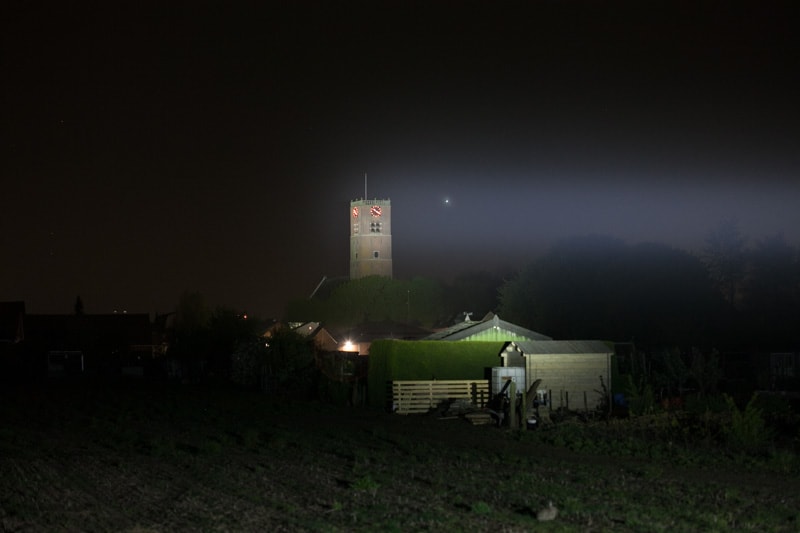



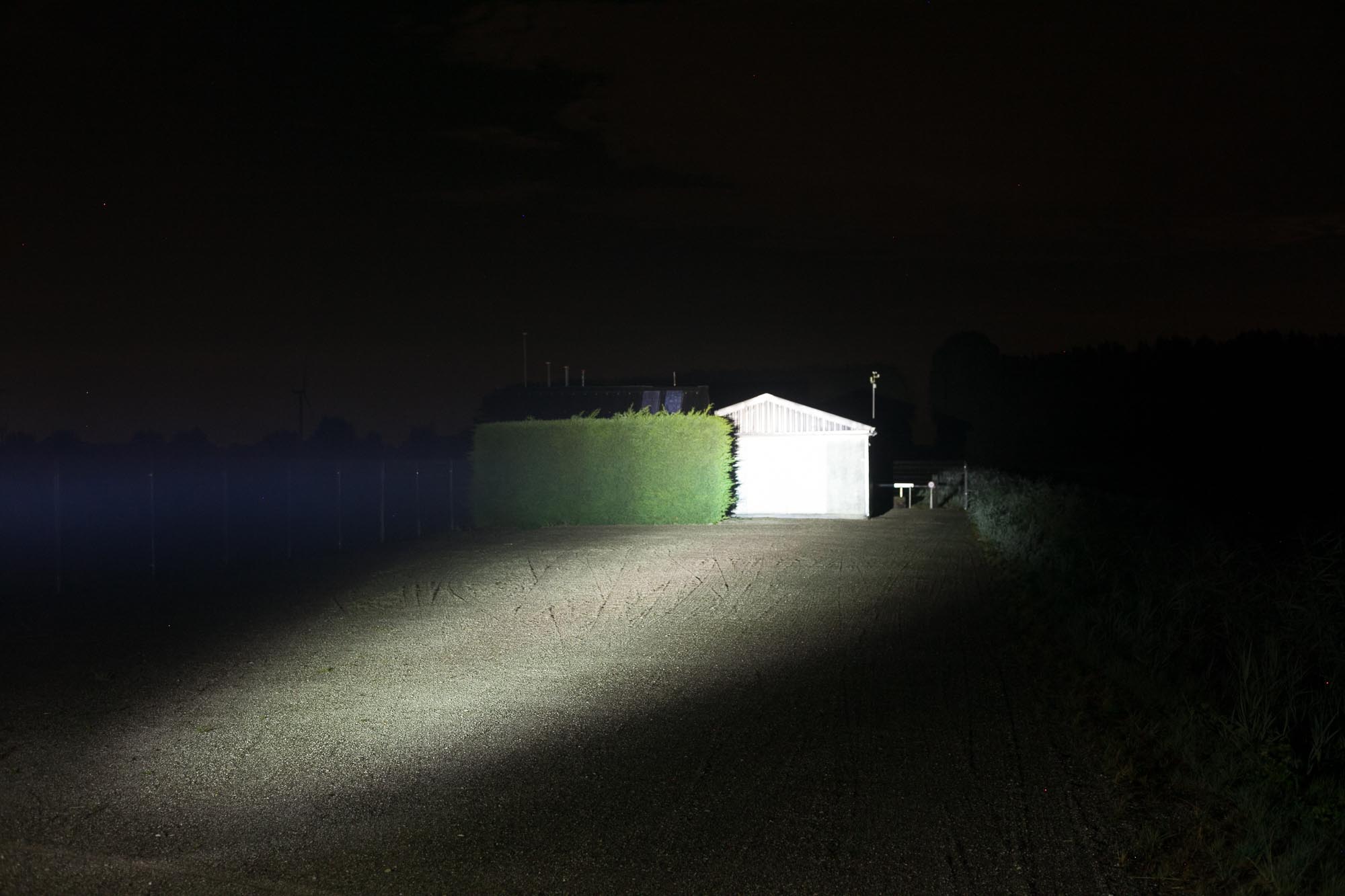
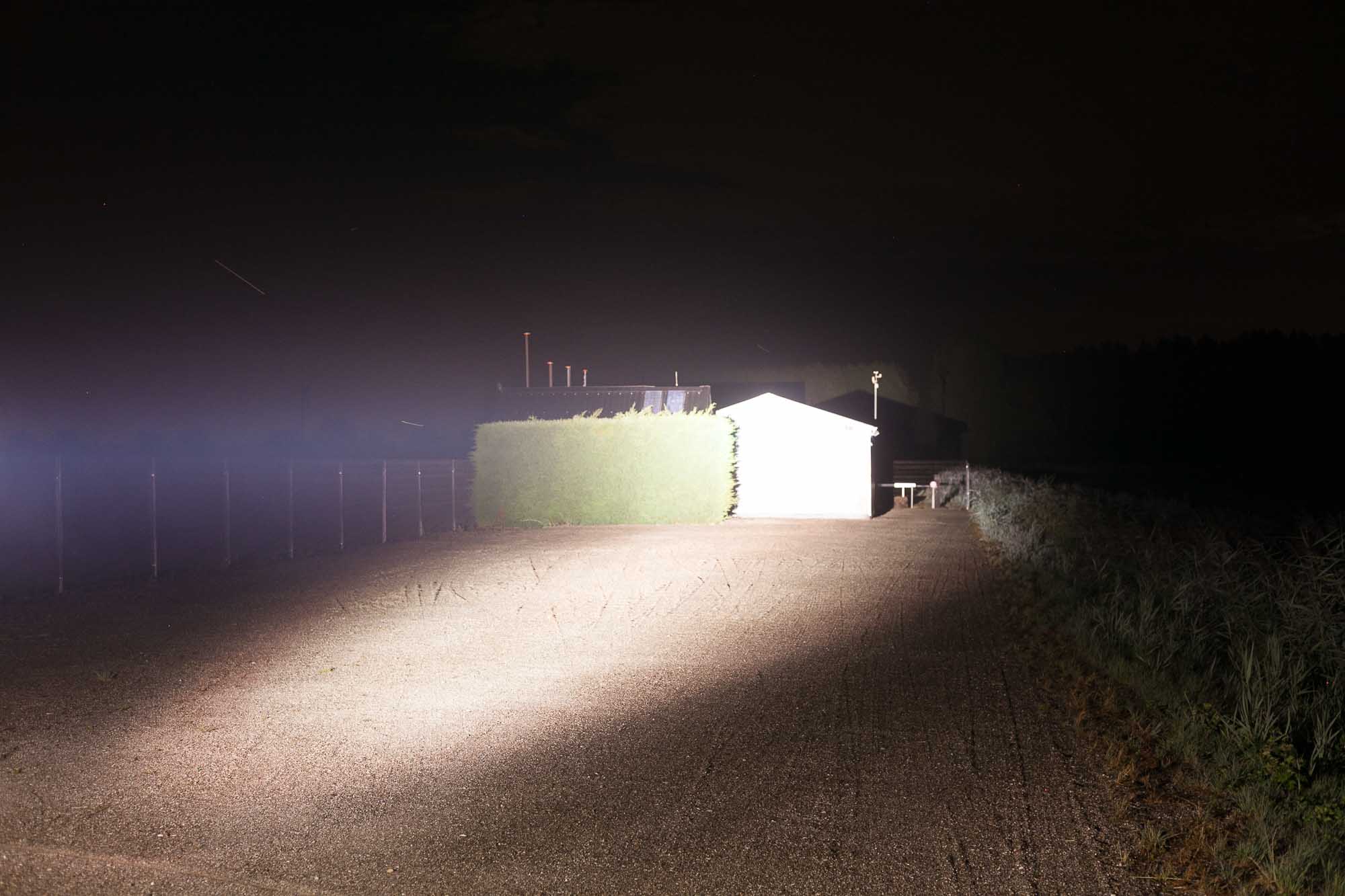

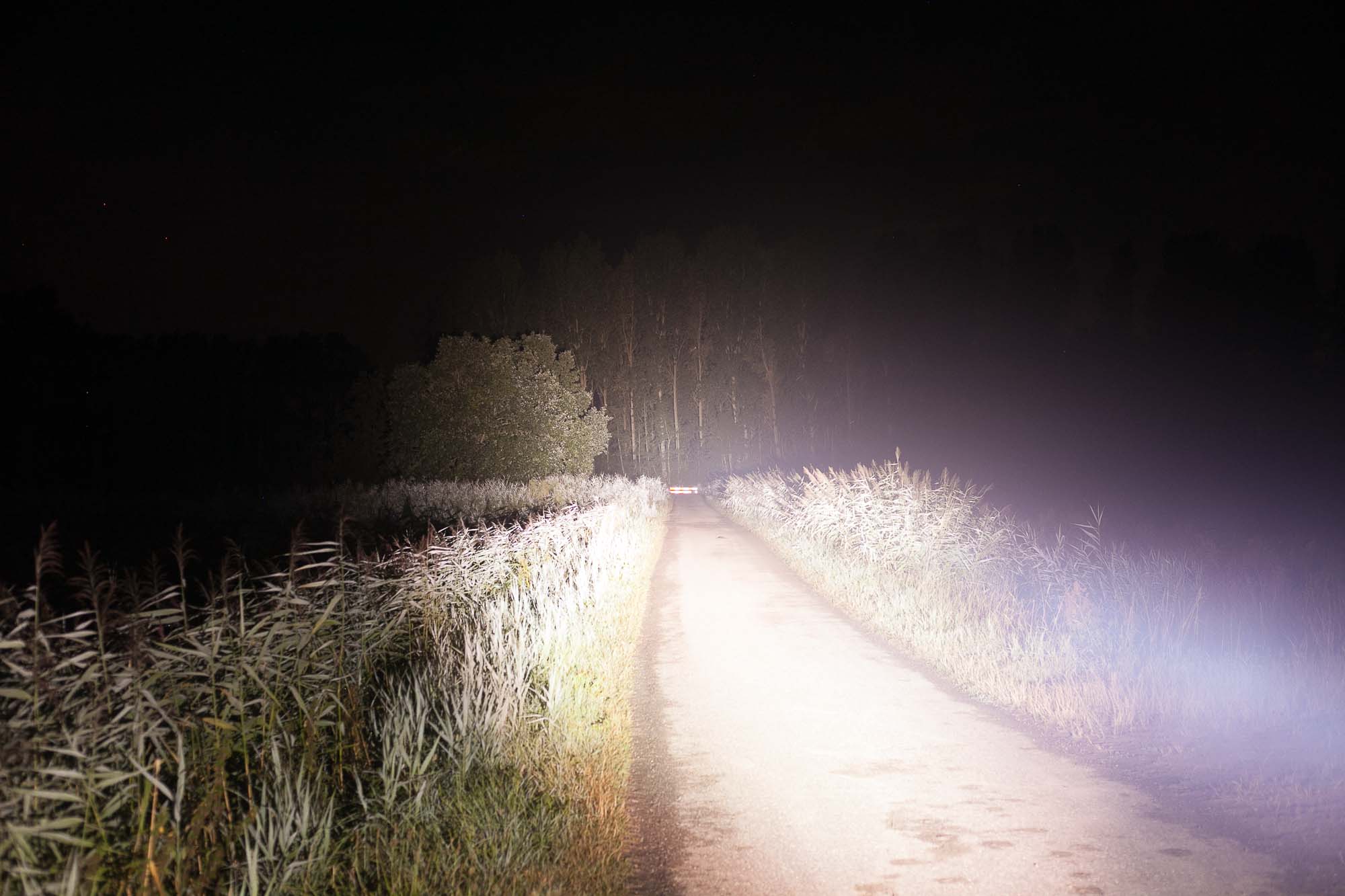
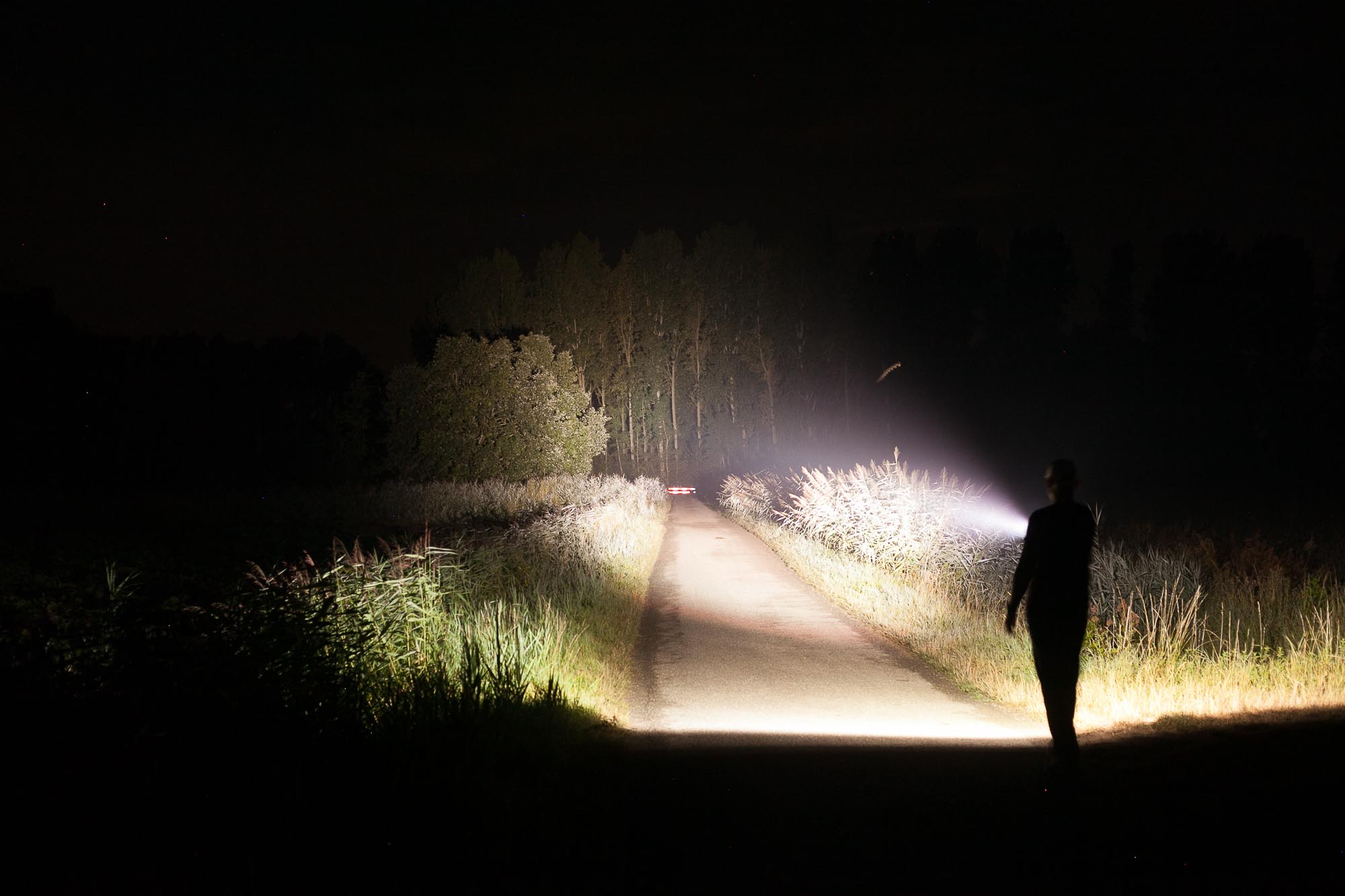
Video review: with some beamshots
Disclaimer: This flashlight was sent to me for review at no cost by Nealsgadgets. I have not been paid to review, nor have I been holding back on problems or defects.
Final Verdict
Pros
- Very interesting powerful beam with 4300K
- Plenty bright in High, and Low mode
- Simple UI
Cons
- Very sensitive (and old) technology (mine broke without any abuse)
- Questionable warranty EDIT: I am going to send it back and see their actual warranty)
- Not reaching claimed output, nor beam distance
- Manual is in Chinese only
- Very short runtimes compared to LED flashlights
- 8*battery carrier would have been better, or even 4-8* 21700 batteries.
Explanation on star ratings:
1: Avoid: my phone flashlight would be a better choice – 2: Poor: significant defect or issues; almost unusable – 3: Average: some defects or issues; but still usable 4: Good: recommended (minor issues) – 5: Great: highly recommended

? stars:
If you’re still dreaming about HID flashlights, you are presumably very interested in this particular one. It’s the latest addition to the FireFoxes family. The beam and the way the HID produces light are extremely interesting. With only 2 modes, it’s very easy to use, but it has quite a few shortcomings compared to current LED offerings.
Edit: My problem might actually be covered under warranty, so I will be shipping it back to Neal.
Fire Foxes FF5GT discount code
Coupon code: 1LumenNew or 1Lumen711
Or buy one of the Accessories: filter, lenses, spare bulbs, pouch, long battery tube.
1lumen selects and reviews products personally. We may earn affiliate commissions through our links, which help support our testing.